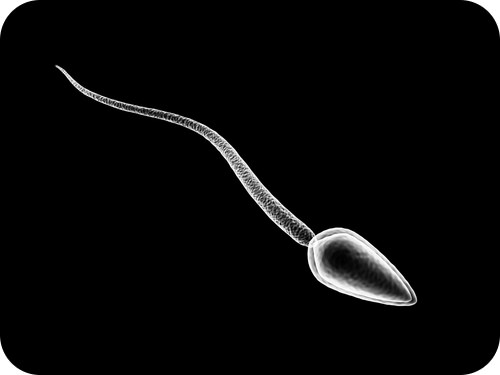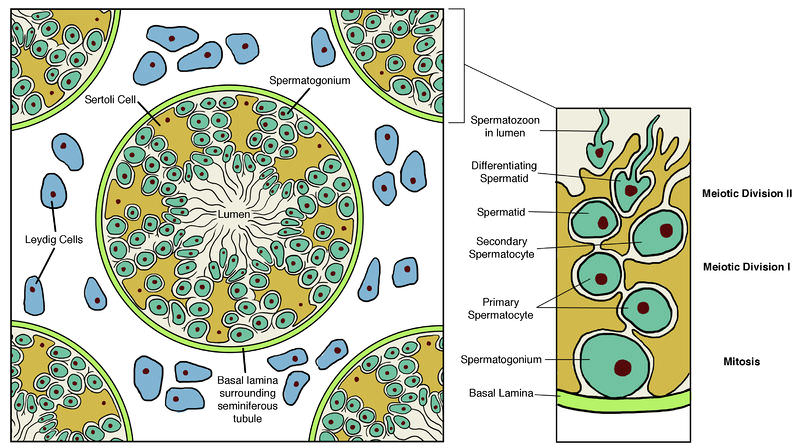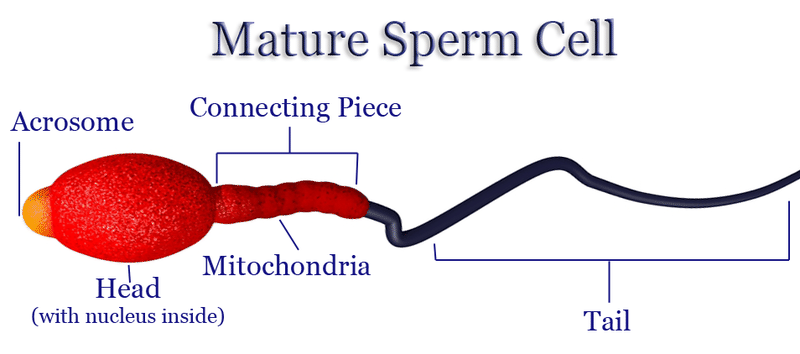13.56: Sperm
- Page ID
- 13331
\( \newcommand{\vecs}[1]{\overset { \scriptstyle \rightharpoonup} {\mathbf{#1}} } \)
\( \newcommand{\vecd}[1]{\overset{-\!-\!\rightharpoonup}{\vphantom{a}\smash {#1}}} \)
\( \newcommand{\dsum}{\displaystyle\sum\limits} \)
\( \newcommand{\dint}{\displaystyle\int\limits} \)
\( \newcommand{\dlim}{\displaystyle\lim\limits} \)
\( \newcommand{\id}{\mathrm{id}}\) \( \newcommand{\Span}{\mathrm{span}}\)
( \newcommand{\kernel}{\mathrm{null}\,}\) \( \newcommand{\range}{\mathrm{range}\,}\)
\( \newcommand{\RealPart}{\mathrm{Re}}\) \( \newcommand{\ImaginaryPart}{\mathrm{Im}}\)
\( \newcommand{\Argument}{\mathrm{Arg}}\) \( \newcommand{\norm}[1]{\| #1 \|}\)
\( \newcommand{\inner}[2]{\langle #1, #2 \rangle}\)
\( \newcommand{\Span}{\mathrm{span}}\)
\( \newcommand{\id}{\mathrm{id}}\)
\( \newcommand{\Span}{\mathrm{span}}\)
\( \newcommand{\kernel}{\mathrm{null}\,}\)
\( \newcommand{\range}{\mathrm{range}\,}\)
\( \newcommand{\RealPart}{\mathrm{Re}}\)
\( \newcommand{\ImaginaryPart}{\mathrm{Im}}\)
\( \newcommand{\Argument}{\mathrm{Arg}}\)
\( \newcommand{\norm}[1]{\| #1 \|}\)
\( \newcommand{\inner}[2]{\langle #1, #2 \rangle}\)
\( \newcommand{\Span}{\mathrm{span}}\) \( \newcommand{\AA}{\unicode[.8,0]{x212B}}\)
\( \newcommand{\vectorA}[1]{\vec{#1}} % arrow\)
\( \newcommand{\vectorAt}[1]{\vec{\text{#1}}} % arrow\)
\( \newcommand{\vectorB}[1]{\overset { \scriptstyle \rightharpoonup} {\mathbf{#1}} } \)
\( \newcommand{\vectorC}[1]{\textbf{#1}} \)
\( \newcommand{\vectorD}[1]{\overrightarrow{#1}} \)
\( \newcommand{\vectorDt}[1]{\overrightarrow{\text{#1}}} \)
\( \newcommand{\vectE}[1]{\overset{-\!-\!\rightharpoonup}{\vphantom{a}\smash{\mathbf {#1}}}} \)
\( \newcommand{\vecs}[1]{\overset { \scriptstyle \rightharpoonup} {\mathbf{#1}} } \)
\( \newcommand{\vecd}[1]{\overset{-\!-\!\rightharpoonup}{\vphantom{a}\smash {#1}}} \)
\(\newcommand{\avec}{\mathbf a}\) \(\newcommand{\bvec}{\mathbf b}\) \(\newcommand{\cvec}{\mathbf c}\) \(\newcommand{\dvec}{\mathbf d}\) \(\newcommand{\dtil}{\widetilde{\mathbf d}}\) \(\newcommand{\evec}{\mathbf e}\) \(\newcommand{\fvec}{\mathbf f}\) \(\newcommand{\nvec}{\mathbf n}\) \(\newcommand{\pvec}{\mathbf p}\) \(\newcommand{\qvec}{\mathbf q}\) \(\newcommand{\svec}{\mathbf s}\) \(\newcommand{\tvec}{\mathbf t}\) \(\newcommand{\uvec}{\mathbf u}\) \(\newcommand{\vvec}{\mathbf v}\) \(\newcommand{\wvec}{\mathbf w}\) \(\newcommand{\xvec}{\mathbf x}\) \(\newcommand{\yvec}{\mathbf y}\) \(\newcommand{\zvec}{\mathbf z}\) \(\newcommand{\rvec}{\mathbf r}\) \(\newcommand{\mvec}{\mathbf m}\) \(\newcommand{\zerovec}{\mathbf 0}\) \(\newcommand{\onevec}{\mathbf 1}\) \(\newcommand{\real}{\mathbb R}\) \(\newcommand{\twovec}[2]{\left[\begin{array}{r}#1 \\ #2 \end{array}\right]}\) \(\newcommand{\ctwovec}[2]{\left[\begin{array}{c}#1 \\ #2 \end{array}\right]}\) \(\newcommand{\threevec}[3]{\left[\begin{array}{r}#1 \\ #2 \\ #3 \end{array}\right]}\) \(\newcommand{\cthreevec}[3]{\left[\begin{array}{c}#1 \\ #2 \\ #3 \end{array}\right]}\) \(\newcommand{\fourvec}[4]{\left[\begin{array}{r}#1 \\ #2 \\ #3 \\ #4 \end{array}\right]}\) \(\newcommand{\cfourvec}[4]{\left[\begin{array}{c}#1 \\ #2 \\ #3 \\ #4 \end{array}\right]}\) \(\newcommand{\fivevec}[5]{\left[\begin{array}{r}#1 \\ #2 \\ #3 \\ #4 \\ #5 \\ \end{array}\right]}\) \(\newcommand{\cfivevec}[5]{\left[\begin{array}{c}#1 \\ #2 \\ #3 \\ #4 \\ #5 \\ \end{array}\right]}\) \(\newcommand{\mattwo}[4]{\left[\begin{array}{rr}#1 \amp #2 \\ #3 \amp #4 \\ \end{array}\right]}\) \(\newcommand{\laspan}[1]{\text{Span}\{#1\}}\) \(\newcommand{\bcal}{\cal B}\) \(\newcommand{\ccal}{\cal C}\) \(\newcommand{\scal}{\cal S}\) \(\newcommand{\wcal}{\cal W}\) \(\newcommand{\ecal}{\cal E}\) \(\newcommand{\coords}[2]{\left\{#1\right\}_{#2}}\) \(\newcommand{\gray}[1]{\color{gray}{#1}}\) \(\newcommand{\lgray}[1]{\color{lightgray}{#1}}\) \(\newcommand{\rank}{\operatorname{rank}}\) \(\newcommand{\row}{\text{Row}}\) \(\newcommand{\col}{\text{Col}}\) \(\renewcommand{\row}{\text{Row}}\) \(\newcommand{\nul}{\text{Nul}}\) \(\newcommand{\var}{\text{Var}}\) \(\newcommand{\corr}{\text{corr}}\) \(\newcommand{\len}[1]{\left|#1\right|}\) \(\newcommand{\bbar}{\overline{\bvec}}\) \(\newcommand{\bhat}{\widehat{\bvec}}\) \(\newcommand{\bperp}{\bvec^\perp}\) \(\newcommand{\xhat}{\widehat{\xvec}}\) \(\newcommand{\vhat}{\widehat{\vvec}}\) \(\newcommand{\uhat}{\widehat{\uvec}}\) \(\newcommand{\what}{\widehat{\wvec}}\) \(\newcommand{\Sighat}{\widehat{\Sigma}}\) \(\newcommand{\lt}{<}\) \(\newcommand{\gt}{>}\) \(\newcommand{\amp}{&}\) \(\definecolor{fillinmathshade}{gray}{0.9}\)
How many sperm does it take to fertilize an egg?
85 million sperm per day are produced...per testicle. That's 170,000,000 every day. This means that a single male may produce more than a quadrillion (1,000,000,000,000) sperm cells in his lifetime! But it only takes one to fertilize an egg.
Production and Delivery of Sperm
A sexually mature male produces an astounding number of sperm—typically, hundreds of millions each day! Sperm production usually continues uninterrupted until death, although the number and quality of sperm decline during later adulthood.
Spermatogenesis
The process of producing mature sperm is called spermatogenesis. Sperm are produced in the seminiferous tubules of the testes and become mature in the epididymis. The entire process takes about 9 to 10 weeks.
If you look inside the seminiferous tubule shown in Figure below, you can see cells in various stages of spermatogenesis. The tubule is lined with spermatogonia, which are diploid, sperm-producing cells. Surrounding the spermatogonia are other cells. Some of these other cells secrete substances to nourish sperm, and some secrete testosterone, which is needed for sperm production.
 Seminiferous Tubule. Cross section of a testis and seminiferous tubules.
Seminiferous Tubule. Cross section of a testis and seminiferous tubules.Spermatogonia lining the seminiferous tubule undergo mitosis to form primary spermatocytes, which are also diploid. The primary spermatocytes undergo the first meiotic division to form secondary spermatocytes, which are haploid. Spermatocytes make up the next layer of cells inside the seminiferous tubule. Finally, the secondary spermatocytes complete meiosis to form spermatids. Spermatids make up a third layer of cells in the tubule.
Sperm Maturation
After spermatids form, they move into the epididymis to mature into sperm, like the one shown in Figure below. The spermatids grow a tail and lose excess cytoplasm from the head. When a sperm is mature, the tail can rotate like a propeller, so the sperm can propel itself forward. Mitochondria in the connecting piece produce the energy (ATP) needed for movement. The head of the mature sperm consists mainly of the nucleus, which carries copies of the father’s chromosomes. The part of the head called the acrosome produces enzymes that help the sperm head penetrate an egg.
 Mature Sperm Cell. A mature sperm cell has several structures that help it reach and penetrate an egg. These structures include the tail, mitochondria, and acrosome. How does each structure contribute to the sperm’s function?
Mature Sperm Cell. A mature sperm cell has several structures that help it reach and penetrate an egg. These structures include the tail, mitochondria, and acrosome. How does each structure contribute to the sperm’s function?Ejaculation
Sperm are released from the body during ejaculation. Ejaculation occurs when muscle contractions propel sperm from the epididymis. The sperm are forced through the ducts and out of the body through the urethra. As sperm travel through the ducts, they mix with fluids from the glands to form semen. Hundreds of millions of sperm are released with each ejaculation.
Summary
- Sperm are produced in the testes in the process of spermatogenesis.
- Sperm mature in the epididymis before being ejaculated from the body through the penis.
Review
- Outline the process of spermatogenesis. Name the cells involved in the process?
- Where do sperm mature and how do they leave the body?
- If a man did not have functioning epididymis, predict how his sperm would be affected. How would this influence his ability to reproduce?
- How does each mature sperm structure contribute to the sperm’s function?
| Image | Reference | Attributions |
 |
[Figure 1] | Credit: Image copyright Scivit, 2014 Source: http://www.shutterstock.com License: CC BY-NC |
 |
[Figure 2] | Credit: Laura Guerin Source: CK-12 Foundation License: CC BY-NC 3.0 |
 |
[Figure 3] | Credit: Image copyright Scivit, 2014 Source: http://www.shutterstock.com License: Used under license from Shutterstock.com |

